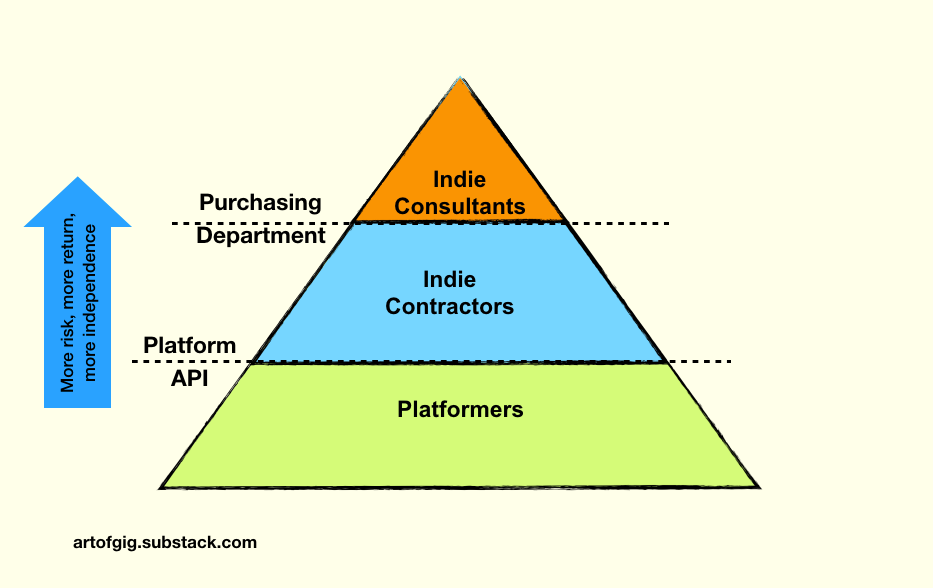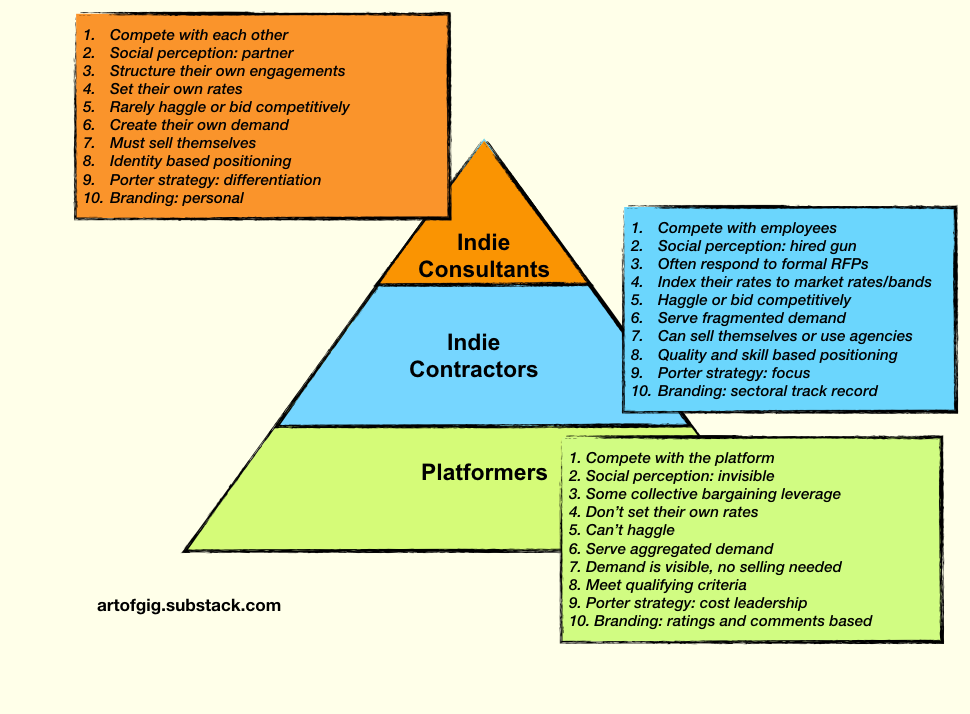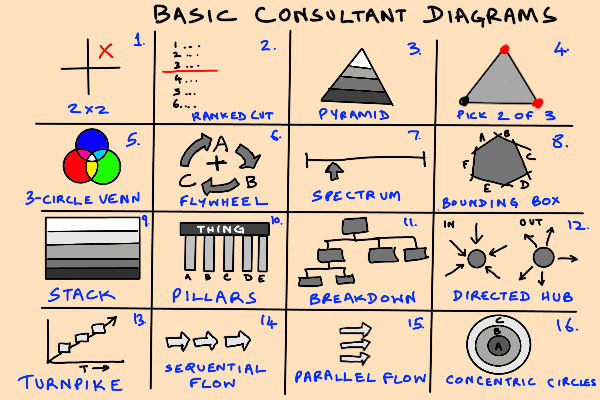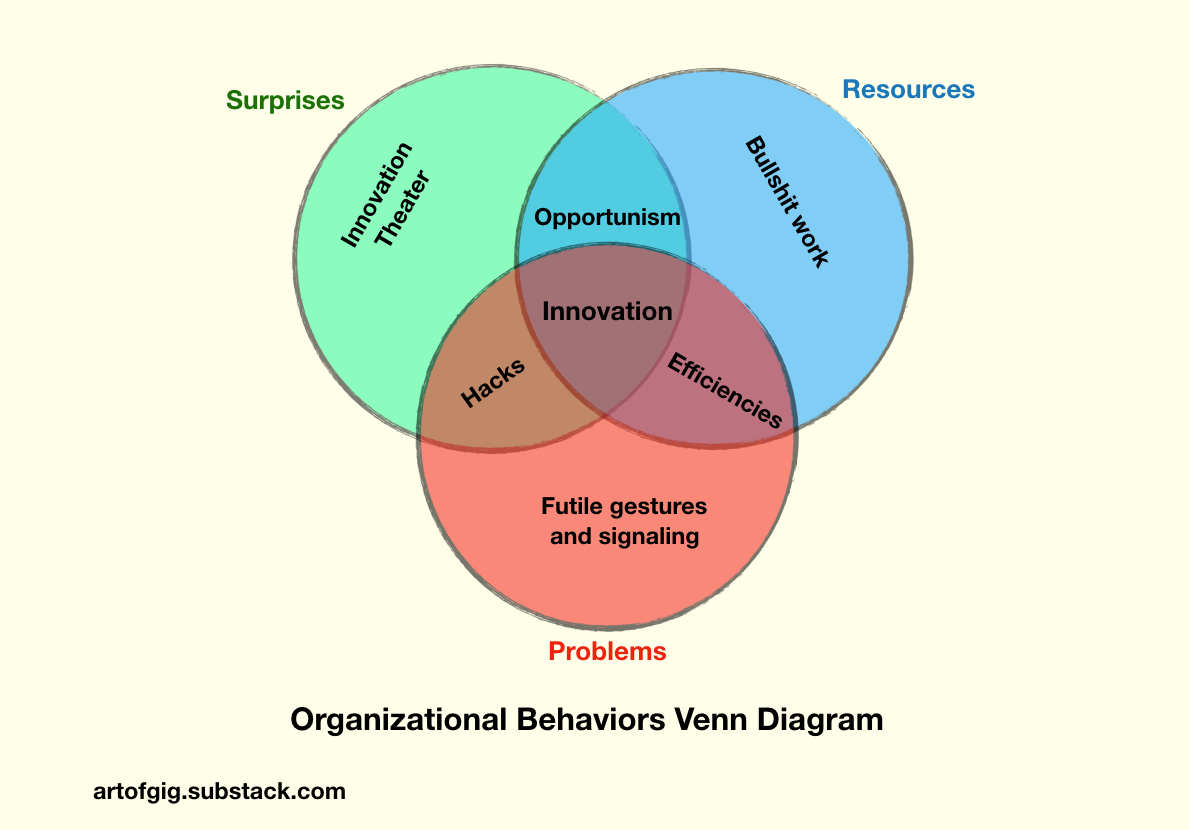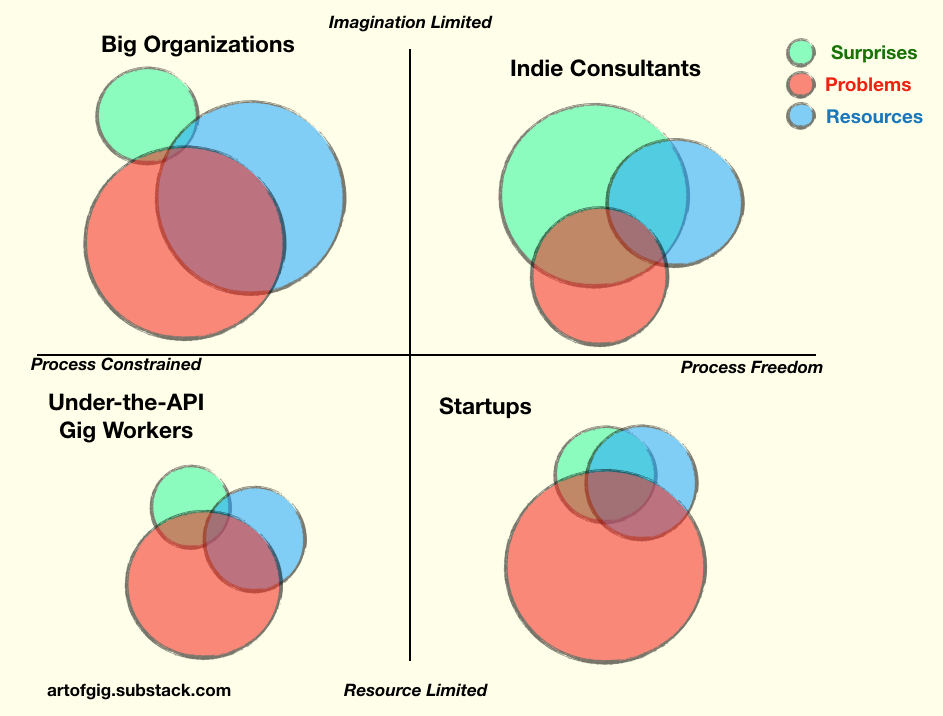The most common hard question I get around consulting work is: how do I find clients to get bootstrapped as an indie consultant? It is at once the most distastefully grubby practical question you can ask, and the most sublimely philosophical one.
In this issue, I want to offer an answer based partly on my recent ribbonfarm post, The Internet of Beefs, which went viral a couple of weeks ago. It’s a genuinely dangerous answer that can screw up your indie consulting career if implemented poorly, so I want to present it with some care. Read the whole article through and think carefully before adopting this approach, since running with it half-assed really can blow up in your face and make you not just unretainable as a consultant, but too toxic to even employ in a regular job. This is not theoretical. I know people who’ve blown themselves up this way.
Clayton Christensen, 1952-2020 photo by Remy Steinegger CC BY-SA 2.0
This is also my tribute issue for Clayton Christensen, developer of the disruptive idea of “disruption”, who passed away last week. You could say that the answer I’m offering in this issue is a way to approach indie consulting bootstrapping as a non-classical disruption problem. Non-classical because you are the disruptive product, not something you design.
Again, not being theatrical about the risks here. They are real. I offer some safety tips at the end. Primum non nocere and caveat emptor etc.
Bootstrapping ≠ First Client
The question of getting clients is distastefully grubby because there are so many soul-destroying bad answers out there that will kinda-sorta “work” in the sense of generating income, but will dehumanize you and practically make you want to kill yourself. Which explains why so many of the people who seem able to make them work either clearly have no soul, or are in deep denial about their ongoing destruction of it.
On the other hand, it is sublimely philosophical because if you squint a bit, it is almost the same as why do I exist and what is the meaning of MY life?
Many aspiring indie consultants manage to land a first client via a mix of mighty struggling, selling themselves short, and luck. Then they fervently hope that that first gig will magically turn into a steady stream of gigs via referrals.
Then they are shocked when that doesn’t happen. Landing the second client turns out to be just as hard or harder. And the third, and the fourth. Eventually beginner’s luck dries up and they face gambler’s ruin. Because that’s what this approach is. Gambling. You aren’t bootstrapping at all. You’re just failing painfully slowly. Your best outcome is actually to fail fast enough that you can go back to the paycheck economy without your psyche destroyed by the experience.
Bootstrapping is not about getting your first client, but discovering your first non-brute-force mechanism for driving demand that actually works.
Of the 3 layers of the free-agent world, which I covered last week, indie consultant, contractor, and platformer, the question is only meaningful and hard at the indie consultant level. The mechanism is simpler at lower levels of the gig economy. Contractors just have to do a slightly different version of a job hunt, and platformers simply have to sign up on some website. They face what Peter Thiel called a 1-to-n problem. You are solving for becoming the nth Photoshop jockey or the nth Uber driver.
Indie consultants are faced with a 0-1 challenge: true bootstrapping. They have to become the first version of themselves that there is a demand for. They have to sort of “IPO” as a unique stock in a public conversation, not labor anonymously backstage.
I don’t have a general answer — this is very much a 1:1 coaching type problem — but I do have a general approach to an answer, which relies on beefs. Let me illustrate with my own case.
Case Study: Me
The top 3 articles of the hundreds I’ve written, in terms of how much they drove cold inbound leads for consulting gigs, are the following. What feature you think they have in common?
-
The Gervais Principle (2009): A dark/satirical take on office politics and corporate sociopathy that went hugely viral back in the day.
-
Entrepreneurs are the New Labor (2012): A cynical take on heroic valorization of founders, arguing that VCs are to founders as management to labor.
-
Fat thinking and Economies of Variety (2016): A post arguing for fat startups and messy, wasteful, play-like innovation over “lean” thinking.
It’s not that they are dark and satirical or contrarian. I’ve written other dark/satirical or contrarian things that led to no gigs.
It’s not that they showcase deep expertise in a subject. They don’t. In fact they largely showcase my shallow, self-taught amateurishness on the underlying topics.
It’s not that they offer step-by-step playbooks to solving the problems they frame. They don’t.
The correct answer is that they each pick a beef worth picking, but not too strongly.
-
The Gervais Principle picks a beef against feel-good “nice” management thinking that dominated the pop-business literature at the time (I helped drive the surge of interest in darker understandings of business circa 2009-12 I think).
-
Entrepreneurs are the New Labor picks a beef against people in the tech sector shilling what has come to be known as “hustle porn” and flattering founders with a Hero self-image that blinds them to industry dynamics and debilitating behaviors.
-
Fat Thinking picked a beef with the lean six-sigma crowd in big corporations, and the lean startup crowd in the startup scene.
But importantly, none of these is what you might call “pure beef” where the fight and criticism of an opposed perspective are the main focus or content.
They are what you might call “20% beef.” Where the starting point is rejecting some core sacred-cow axiom of a prevailing orthodoxy, and then building something new and interesting, based on additional ideas and novel elements, on that foundation of principled dissent. It is something like rejecting Euclid’s parallel line postulate and going out on a limb to see if you can build a non-Euclidean geometry.
For example, the assumptions I rejected in my 3 articles above are:
-
Executives are nice and managers know what they’re doing (Gervais Principle)
-
Entrepreneurs/founders are heroes (New Labor)
-
Efficiency and optimization are good things (Fat Thinking)
So one good answer to how to bootstrap from 0 to 1 is: indie consultants bootstrap with beefs. It’s not the only way, and it’s certainly not the safest way, but it’s a fun way that is very intellectually satisfying and validating when it works, and is the opposite of soul-destroying and dehumanizing.
But implementing that answer is a remarkably hard challenge, because it involves a delicate bit of threading the needle, and sending a hard-to-fake disruption signal out in the world.
Too Much Beef, Too Little Beef
Bootstrapping with beefs can fail in 2 ways: via too much beef, or too little.
On the one hand, you can adopt too beefy a posture and end up crashing into the Internet of Beefs. This is pure downside.
I’ve done that. For example, an early book review I wrote, of Blue Ocean Strategy, (2007) was pure beef. Another, a review of Seth Godin’s Tribes (2008) had the same problem. In both cases, I stand by my criticism, and believe they are bad books. But the point is, the reviews were 100% beef. I didn’t reject selected premises and build something else better on the alternative foundation. In both cases, it would have been possible; I just didn’t bother to do it. I did the equivalent of criticizing Euclid’s Elements with a “geometry is bad and geometers are evil” line of attack rather than building a non-Euclidean geometry.
On the other hand, you can put in a lot of work into posts that solidly cover a topic in an entirely non-beefy way, and get a lot of gratitude and praise, but generate no leads. This is a “safe” way to fail in the short term, but in the long term is death by slow starvation.
I’ve done that too. Three examples of my own are The Seven Dimensions of Positioning (2010), Economies of Scale, Economies of Scope (2012), and Product-Driven vs. Customer-Driven (2014). I had high hopes of all 3 as consulting lead-gen essays. But though I got a lot of praise and gratitude for them, as lead generation essays they were utter flops. Why? Because they weren’t alternatives to existing ways of doing things. They weren’t non-Euclidean geometries. They weren’t beefy disruptions of prevailing orthodoxies.
Bootstrapping with beefs doesn’t have to be done with writing. You could do a book, or a talk, or a show-over-tell artifact that falsifies a commonly held belief via counterexample. Or even just a twitter rant. If you’re not a creator type, you could develop a sales pitch for use in 1:1 conversational selling that’s based on a beefy take. There’s many ways to “go non-Euclidean”.
Many ways, but no easy ways. Discovering and developing a genuine beef into an artful calling card that lands you gigs is hard work. That’s why it’s a costly signal. You can’t fake it by simple bullshitting.
You have to put in the work of:
-
Spotting a widespread pattern of disillusionment in the margins
-
Identifying the prevailing orthodoxy driving the disillusionment
-
Analyzing its foundations
-
Rejecting one or more flawed premises driving the disillusionment
-
Adding imaginative alternative premises
-
Running with it to see where the whole thing can take you
-
Becoming conscious of what and who you’re for and against
-
Articulating it out there in public and standing behind it.
Yes, this is just Clayton Christensen’s ideas applied to you, personally, as an idea economy product, finding and serving an underserved marginal market before attacking the core.
The work is hard not because it takes effort or time. None of those articles took me more than a couple of days to write. The work is hard because it takes a certain amount of courage and a good deal of taste. If you don’t feel a bit of an adrenalin rush, a sense of a fight-or-flight, a sense of burning bridges, while working on them, you’re not doing it right.
Without this work, you’ll end up with either too much beef or too little beef, and be left with either a pointless fight or deathly silence.
Differentiation = Right Amount of Beef
Why does 20% beef work as a bootstrapping solution?
Last week, I noted that indie consultants pursue a differentiation strategy in terms of Michael Porter’s 3 generic strategies (differentiation is indie consultants, focus is contractors, low-cost leadership is platformers). But most beginning indie consultants don’t understand what differentiation means in our line of work.
Even ones who’ve figured out a differentiation that works often are unsure about how/why it is working. They just pray it doesn’t suddenly stop. Hell I was that way as late as 2014, three years into my indie career, as evidenced by the date of my last “failed lead-gen” blog post cited above.
So what is differentiation for an indie consultant?
Differentiation is the right amount of beef in your positioning; notionally about 20%.
Most mistakenly assume differentiation is about a nice website with pithy, superlative-laden positioning statements, glowing testimonials from nobodies, and professional headshots. All pulled together with a headline declaring something like “I help executives deliver value by blah blah blah zzzzzz 😴😴😴”
No, that’s not a differentiated offering. That’s a commodity offering putting on a nice suit.
See the thing is, as an indie consultant, you’re not selling a product that can have different “features” relative to the competition. Nor are you claiming skills others lack, or 5-star ratings putting you in a top performance category. That’s contractors and platformers. People who sell maker skills or just plain labor.
You are modeling a clear, generative way to break away from something that a lot of people are disillusioned with.
You’re offering an irreversible path of political action.
You’re making your support for that action mean something by association.
You are meaning.
Some of you will recognize the element of Hannah Arendt philosophy in here: we’re talking about “action” in a spotlight over “making” or “laboring” backstage. I highly recommend The Human Condition as philosophical background here.
Beefy Positioning
All indie consultant positioning that works amounts to: it doesn’t have to be this prevailing orthodox way that you’ve been disillusioned by, there is another, better way, and here’s how you go down that road.
Even if there is a product-like element to what you’re offering, like say a workshop or training package, it’s not the quality or effectiveness that matters, but the fact that it embodies a true, bridges-burned alternative to something that isn’t working.
And when you’re offering services to senior executives in particular, VP and up at mid-to-large companies, the “alternative way” is the sum total of what they’re buying.
They don’t need your expertise. They are the experts in their business.
They don’t need your hands-on doer skills. That’s what contractors and employees are for, not consultants.
They don’t need raw labor. That’s Uber-for-X, whatever their X is.
They don’t need you for rah-rah motivation driving them from mediocre to superlative performance (or pretending to). That’s for middle managers and rank-and-file.
Executives typically got where they are not by being exceptional performers, but by being bold and opinionated decision-makers who took interesting risks with a broad but mediocre set of abilities. They’re generally in the market for opinions worth betting on, not knowledge or skills per se.
They need you as an ideological partner-in-arms to drive an “alternative way” agenda through. You are their ideological optionality. Betting on you should represent a meaningful risk.
And you can’t just create ideological optionality by painting a cloud of superlatives around your headshot, and expect that halo of meaningless blather to do the work. You have to offer something like a weaponized schism that they can use to force a decision, and drive the action down one road rather than another. That’s what the 8-step recipe I outlined earlier aims to craft.
It’s a tall order, and fraught with all sorts of risks if you actually try it. So here are some safety rules for running this 20% beef bootstrapping playbook, whatever medium you choose.
Safety Rules!
Here’s a set of 12 rules that can help to keep you safe and generative when you try to bootstrap with beefs (or level up your game). They aren’t guaranteed to keep you perfectly safe. Conflict is by definition risky. You might misjudge a tone. You might push too hard or not hard enough. You might provoke someone who goes all psychopath on you. You might get hijacked by your own emotions and get sucked deeper into a fight than you intended to. You could get distracted from trying to solve a problem to trying to make an adversary suffer.
But still, following these rules should load things in your favor, and mitigate the risks.
-
Add 3-4 novel elements for every 1 rejected orthodoxy element
-
Warren Buffett rule: praise by name, criticize by category
-
Offer an exit to a better way, rather than a voice in a fight
-
Bring out the funny side, which is not the same as being haha funny
-
Reject what you reject with force and clarity, don’t pull your punches
-
Embrace what you embrace with doubt and qualifications
-
Follow your truth where it leads you, not your adversaries where they draw you
-
Openly acknowledge any motivating resentments and set them aside
-
You don’t have to pick every battle, but you do have to pick a few
-
Disengage from the rejected way, do not seek to destroy it
-
Firmly reject resentment-driven mooks who want to fight for you
-
Be kind. If you forget every other rule, don’t forget this one.
So that’s it.
RIP Clayton Christensen.
Go forth and disrupt, with 20% beef.

